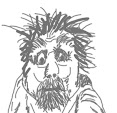Starting in the Fall of 1982, Utah–particularly along the Wasatch front–had record or near record rainfall and precipitation every month from September of that year through June 1983. The mountains in early June looked more like the mountains do in March of a typical year with deep snow still halfway down the slopes. These photos were taken between March and the first week of June in 1983 in Spanish Fork Canyon, Provo, and Salt Lake City. So, as we struggle through the dry years, remember that the wet ones can be just as bad, or worse, in their own way.
In late February or early March 1983, the first sign of the trouble to come was the reactivation of a small landslide in Provo labeled on the geologic map as the Easter Cross landslide. Developers, with the blessing of the city, had allowed lots to be drawn up for sale on the old landslide. I am standing near the active toe of the landslide as it crept ever closer to a home that had just been build on one of the lots.
Up in Spanish Fork Canyon, to the south of Provo, an even bigger landslide started moving. Initially, the railroad folks tried to dig up their rails, smooth things out, and relay the rails over the slowly moving landslide. But when it kept moving, they eventually gave up. Here the slide has grown to a huge size, dwarfing the large earth moving equipment that was called in to stabilize the slide. The Spanish Fork River was now dammed and backing up behind the slide creating a serious hazard. If the water rose far enough to top the slide and wash it out, severe flooding would occur downriver.
The lake backing up behind the Thistle Slide covers U.S. Highway 6 and has drowned most of the small town of Thistle. One building stands on higher ground, but it too will succumb to the lake in another few days.
By June the slide had stopped moving, and the lake has expanded to reach its maximum size. A drainage tunnel was installed to prevent the water from over topping the landslide. Today, only a faint shoreline, like a ring-around-the-tub, is visible to those who look for it.
City Creek, which flowed through Salt Lake Valley when the Mormon Pioneers arrived, had been long buried underground in conduits under the city. But in June 1983, the creek could not be contained in its underground path and was directed down through the avenues and out onto State Street along the roads.
At North Temple and 2nd Avenue, City Creek was turned to the south by a high wall of sandbags holding up concrete barriers directing the flow onto State Street in Salt Lake City.
City Creek turned to the south past the LDS Church Office Building onto State Street.
City Creek flowing down the east side of State Street and under the Eagle Gate.
Temporary pedestrian bridges were built along State Street to allow people to cross the river now flowing along the pavement.
In Provo, Utah, the normally dry creek that flows out of Rock Canyon flooded neighborhoods in the area around the Provo LDS Temple. Here Rock Canyon Creek flows down the road on the south side of the Provo Temple toward the Missionary Training Center.
As the flow approached the Missionary Training Center, it was diverted onto 9th East, although by the time I took this photo, a break in the main sandbag channel was allowing some of the flow to head directly toward the MTC.
Farther down 9th east at the corner of the BYU Campus, the water was spread out acoss the entire road and was only a few inches deep on this particular day. And check out that red car. You won't see one of those on the road very often these days.
You can read more about the Thistle Landslide at these sites:
Friday, April 11, 2014
Remembering 1983: The year of the floods in Utah
Labels:
1983,
flooding,
landslide,
Provo,
Salt Lake City,
State Street,
Thistle
Subscribe to:
Post Comments (Atom)













1 comment:
Brother, you caught some great images here. What a time that was..along with the rise of the Great Salt Lake. Thanks for sharing.
Post a Comment